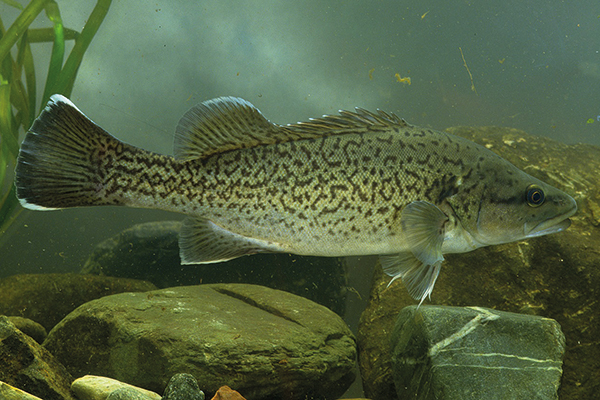Trout Cod (Maccullochella macquariensis)
 Trout Cod. Photo: E. Beaton, ACT Government.
Trout Cod. Photo: E. Beaton, ACT Government.
The native Trout Cod (Maccullochella macquariensis) was listed as an endangered species in the ACT in January 1997 and risks becoming extinct in the Territory unless active steps are taken to protect and maintain its habitat.. It is listed as endangered internationally, nationally and by NSW and as threatened in Victoria. It is extinct in South Australia.
Although originally found through the southern Murray–Darling river system, only a single ‘natural’ remnant population remains (in the Murray River between Yarrawonga and Barmah), with the last natural population disappearing from the ACT in the late 1970s.
Populations have been re-established through translocation in the 1920s and the national recovery program that began in the late 1980s. More than 140,000 fingerlings were released between 1996 and 2007 into the ACT.
The Trout Cod is related to freshwater bass and cod, including the Macquarie Perch, has a speckled blue-grey body pattern and dark stripe through its eye. While fish have been recorded as long as 85 centimetres, as heavy as 16 kilograms and as old as 25 years, most are less than 5 kilograms and few live longer than 12 years.
Trout Cod do not roam far from their ‘home snag’ and always return home. They are believed to form pairs and take parental care of their eggs—as many as 11,000 a year. They spawn in spring and lay the eggs on a hard surface such as submerged logs, clay banks or rocks.
The Trout Cod is a carnivorous, top-order predator with lies in wait for its food—freshwater crustaceans such as yabbies, crayfish and shrimp, fish and aquatic insects.
Conservation threats
The major threats to the continued survival of native fish species in freshwater habitats are reduced water flows, overfishing, habitat alteration and introduced fish species. These threats are all thought have impacted on populations of Trout Cod.
Alteration or destruction of fish habitat is one of the most important causes of native fish decline. Trout Cod habitats have been impacted by sedimentation of streams, reduction in water quality, cold water pollution downstream of Bendora Dam and riparian degradation along the Cotter and Murrumbidgee rivers.
Dam construction on ACT and surrounding rivers since the 1920s caused population isolated. Dams reduce flows downstream and stop fish passage. Barriers isolate fish habitats and fragment fish populations, making populations more vulnerable to random extinction events. Barriers can be structural (e.g. dams, weirs, road crossings) or chemical (e.g. discharge of effluents, pollutants, contaminants) and can be partial or total.
Introduced species, such as Carp and Redfin, have invaded Trout Cod habitats and may compete for food and prey on juvenile Trout Cod. They can also introduce or spread diseases and parasites to native fish.
Climate change also puts fish at risk. Fish can’t regulate their body temperature; given Trout Cod are thought to spawnin response to day length and water temperature, there is a risk that spawning cues can become decoupled with earlier seasonal warming. With more fires and increased rainfall intensity predicted, more sediment may end up in streams, damaging eggs.
Conservation actions
The overall conservation objective of the action plan is to re-establish and maintain in the long term, viable, wild populations of Trout Cod as a component of the indigenous aquatic biological resources of the ACT and as a contribution to regional and national conservation of the species. This includes the need to maintain natural evolutionary processes and resilience.
These actions will be driven by the Trout Cod Action Plan (2018) and the ACT Aquatic and Riparian Conservation Strategy (2018).
To create conditions where Trout Cod and other native fish may thrive, the ACT Government is already contributing to improving conditions for Trout Cod by:
- prohibiting on fishing of the species since 1997
- replanting on the Murrumbidgee River as part of the Million Trees program
- improving fish habitat in the Upper Murrumbidgee Demonstration Reach (the 100 kilometre stretch of river from Bredbo to Casuarina Sands)
- establishing rock groynes and engineered log jams to rehabilitate fish habitat and improve fish passage through the Murrumbidgee River sand slug past Tharwa
- regular monitoring of the fish to inform management decisions.
The action plan outlines how we can:
- protect sites and habitats that are critical to the survival of the species, particularly the reintroduced populations in Bendora Reservoir and the Murrumbidgee River
- manage habitat to conserve existing populations and re-establish new populations
- enhance the long-term viability of populations through management of aquatic habitats, alien fish species, connectivity, stream flows and sedimentation in habitats contiguous to known populations to increase habitat area and connect populations
- establish additional populations through stocking or translocation
- improve understanding of the species’ ecology, habitat and threats through survey, monitoring and research, in particular:
- monitoring reintroduced populations and genetic diversity
- researching movement and dispersal of fish
- breeding biology
- looking at the importance of natural in-stream barriers to population connectivity and the effect of environmental flows
- manage activities to minimise or eliminate threats to fish populations; for example:
- maintain riverine habitats with appropriate seasonal environmental flows, intact riparian zones, pool depths, and minimal sediment inputs from roads and surrounding land use.
- protect and revegetate riparian zones to increase organic matter, provide shade (which buffers water temperatures, provides cover, prevents erosion and filters sediment from run-off)
- minimise sediment addition
- facilitate fish passage to connect habitats and help migration
- improve community awareness and support for Trout Cod and freshwater fish conservation.
More information
- Trout Cod Action Plan (977.5 KB)
- Aquatic and Riparian Conservation Strategy, 2018
- Australian Government Trout Cod species profile
Contact
Email environment@act.gov.au or phone Access Canberra on 13 22 81.

